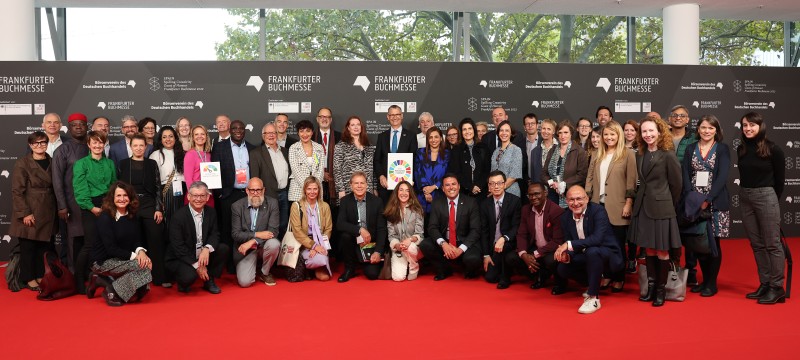The publishing sector’s growing interest in sustainability and climate has accelerated against a background of rising energy prices and increasing cost of living. It was great to see so many publishers and publishing organizations present and already driving many new initiatives to act on climate change.
The carbon-label project fast-tracked established carbon calculators and combined this with a customized web page for a particular book, that gives users a glimpse into how carbon labels and reporting might look like for book production. Now, this is only a prototype. Far more work is needed to make this a reality and the project has generated many new insights. Here I share 4 of the lessons we learnt during the prototype development.
- It is not about labels.
You might be confused to read that a carbon label prototype is not actually about a label. The term “green” or “sustainable” is being increasingly applied from everything from running shoes to toothpaste. Often, these terms imply an industry standard, but are unregulated and increasingly perceived by consumers as a type of “greenwashing”.
We wanted to go beyond ‘good’ and ‘bad’ judgements and bring transparency to the information we communicated on the label, helping the reader build up an idea of how the carbon consumed in a book compares. So, one of the first lessons we learnt is that a carbon label should be about reporting and not a claim of sustainability. Providing additional information and a breakdown of specific emissions categories associated with book production is useful. This is not just for consumers but for everyone across the value chain.
- Our data is good enough (for now)
Our accelerator manifesto is clear, we have to forget about perfect. A print book carbon calculator, developed over two months, has to contain a significant amount of assumptions and industry averages. Nevertheless, we were able to do it in the time frame and were surprised to find that when applied to an individual book, the data is pretty reliable.
Why? There is no getting away from paper and print being the biggest categories in terms of emissions. The best part is that our printers and paper mills have sophisticated and accurate emissions data available. We found many were advanced in their climate reporting and already adopting renewable energy to reduce their impact. Within the calculations this reliable and accurate data input covers around 75% of the total calculations. The result? A total carbon footprint for an individual book, even when combining with industry estimates for other categories, that is close to what we would expect. For the three titles we piloted, the carbon footprint ranged from 1.2 to 2.1 kgs CO2. This corresponds with other calculations of an average books that ranges from between 1kg-3kg of CO2.
- Content creation is tough to calculate and tougher to influence
An important aspect to creating books is the creative process behind translating an idea onto paper. The efforts of authors, illustrators, editors, and publishers to bring books into reality is important and often the “secret sauce” to a successful book. Calculating the associated emissions of this process is tough. Each of these individuals will spend time in an office or their home, they will use energy to review, write and edit, whilst also commuting either by car or public transport. The data here is not available and we had to use estimates based on the region where these people are based.
The calculations for content creation for our piloted titles ranged from 0.28 to 0.53kg CO2 and is often part of the top 3 emission categories for the title. But it is a category which is hard to influence. To reduce this means reducing the time and energy spent working on creating content. While having efficient work systems to save time or using green energy in an office will help, we must also recognize that to maintain our quality as a sector, this category could be worth the emissions!
- The carbon label is about commitment
During the prototype development some initial small scale user testing was conducted with authors, booksellers, customers, and publishers to gauge the potential reaction and appetite for such a carbon label.
Firstly, for customers, there have been many studies that confirm customers like to buy “green”. In our initial small-scale interviews, we discovered customers have very little knowledge of carbon , espcially in relation to books. The carbon label and information were seen as a positive message and commitment to climate from the sector and in some cases raised awareness of climate change.
For publishers and booksellers, the reaction was more cautious. There was a fear that the calculation might be too high, or that it could negatively affect sales. However, during the process, many liked the data insights about the emission categories and could think about sustainable choices, like paper type, that could help drive progress.
Finally, the most positive group were authors. Many were already planning on reaching out to discuss carbon impact and were thrilled to be involved.
“Wow what a privilege for us, so thrilled you chose us, thank you so much. Brilliant initiative and glad we are part of it!” – Authors of a piloted book
Are you in?
With the protype launched, we are ready to see how we might scale this up and make it work in reality. The accelerator is looking for publishers and publishing organizations that are willing to pilot this concept and conduct further customer testing over the next 6 months. If you would like to become involved in this project or our other workstreams please reach out to me on LinkedIn.

